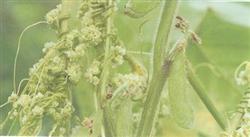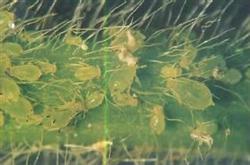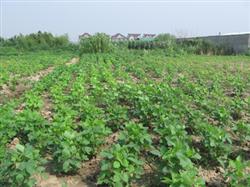Control of soybean dodder

Dodder is also known as yellow rattan and tangled rice seedlings. It's a malignant weed. It harms a variety of crops and can cause the loss of soybean production, which is common in all parts of the country. (1) Morphology: the stem of soybean cocoon silk is yellow, orange-yellow or yellowish green, smooth, glabrous, linear, winding to the left on the host stem. Leaf blade reduced to membranous scales. The flowers are yellow and white, mostly clustered together, in the shape of a hydrangea. Seeds globose, yellowish brown or dark brown, surface rough. One dodder can parasitize more than 300 soybean plants and produce more than 1 million seeds in one season. (2) Prevention and cure method: ① agricultural prevention and cure. Select seeds to prevent soybean seeds from carrying cocoon silk seeds; rotation can rotate with ground claws, millet, corn and sorghum for 2 or 3 years. ② biological control. Lubao No. 1 bacterial agent can be used for control. The use of bacterial agent is early. When Fan Gongzi wound around 2 Mel 3 soybeans, he sprayed a wave of 40 million live spores per milliliter. When spraying, it should be evenly stained with bacterial liquid, and breaking the dodder vine with a stick before spraying can improve the control effect. Chemical control of ③. When the wide filaments are entangled and begin to transform, spray with 10% glyphosate emulsion 400 × 500 times or 48% desloromide EC 100 times.
- Prev

Diseases and control of pollution-free soybean
Soybean aphid is one of the main pests of soybean. Adults and nymphs are used to suck juice on the top leaves, tender leaves and stems of soybean plants. When it is covered with stems and leaves, it can also damage young pods, resulting in plant dwarfing, reducing the number of fruiting branches and pods, reducing 1000-grain weight, and killing the whole plant in serious seedling stage.
- Next

Application of herbicides in soybean field
When the soybean field chooses to use herbicide varieties, it is safe and not easy to produce key points for crops, which is the first, and the second is to consider the control effect of weeds, that is, the control effect is better. Under the condition of good control effect, choose the varieties with lower drug cost as far as possible. There are two kinds of weeds in soybean field: Gramineae weeds and broad-leaved weeds.
Related
- The first cup of black tea in spring, the flavor and history of tea gardens in Kenya, Africa
- The computer can not only choose potatoes, but also grow tea rice. AI will grow winter oolong tea champion.
- It is not only the inflated tea bitten by insects, but also engraved with the four seasons tea in Beipu.
- The Oriental Beauty Tea Festival in Zhuxian County takes the stage at the weekend to experience the plus-size feast of oil tea.
- & quot; Oriental Beauty Tea & Exploration of Emei in Hsinchu, the hometown of quot;
- The new variety of strawberry "Tainong 1" dessert is the first choice with mellow aroma. Crimson gorgeous
- History of Tea in Taiwan: from Wild Inner Mountain to Export Tea Garden
- Two types of Taiwan Oriental Beauty Black Tea won the British three-Star Award for Childhood Tea Xiang Zhang Jiaqi changed from pilot to champion tea maker.
- Banana species and varieties: the planting history of Taiwan Xianren banana and dwarf banana is long, is banana disease resistant?
- Coffee planting Technology: Qianjie Coffee from Seedling to harvesting

